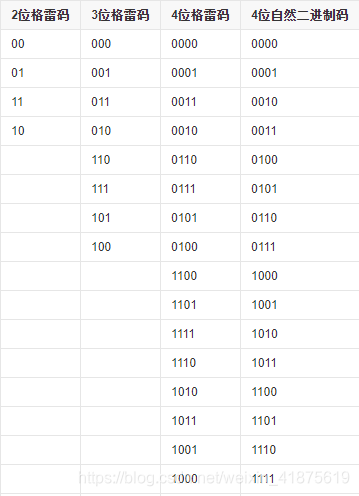Description
The gray code is a binary numeral system where two successive values differ in only one bit.
Given an integer n representing the total number of bits in the code, return any sequence of gray code.
A gray code sequence must begin with 0.
Constraints:
• 1 <= n <= 16
Example
Example 1:
Input: n = 2
Output: [0,1,3,2]
Explanation:
00 - 0
01 - 1
11 - 3
10 - 2
[0,2,3,1] is also a valid gray code sequence.
00 - 0
10 - 2
11 - 3
01 - 1
Example 2:
Input: n = 1
Output: [0,1]
Submissions
经百度百科格雷码可知其转换方法:
基于格雷码是反射码的事实,利用递归的如下规则来构造:
• 1位格雷码有两个码字
• (n+1)位格雷码中的前2n个码字等于n位格雷码的码字,按顺序书写,加前缀0
• (n+1)位格雷码中的后2n个码字等于n位格雷码的码字,按逆序书写,加前缀1
• n+1位格雷码的集合 = n位格雷码集合(顺序)加前缀0 + n位格雷码集合(逆序)加前缀1

因此循环使第(n+1)位的格雷码序列等于 ‘0’+第n位的正序 加 ‘1’+第n位的逆序 即可,最后利用map函数将二进制数字列表转换为整型数组。
map() 会根据提供的函数对指定序列做映射。
第一个参数 function 以参数序列中的每一个元素调用 function 函数,返回包含每次 function 函数返回值的新列表。lambda表示匿名函数。
int() 函数用于将一个字符串或数字转换为整型。
class int(x, base=10),base表示进制数,默认十进制。
实现代码如下:
class Solution:
def grayCode(self, n: int) -> List[int]:
grays = dict()
grays[0] = ['0']
grays[1] = ['0', '1']
for i in range(2, n + 1):
res = []
for pre in grays[i - 1]:
res.append('0' + pre)
for pre in grays[i - 1][::-1]:
res.append('1' + pre)
grays[i] = res
return map(lambda x: int(x, 2), grays[n])




 这篇博客介绍了如何利用递归规则生成格雷码序列。内容涉及格雷码的基本性质,转换方法以及如何通过Python代码实现从n位到(n+1)位的格雷码扩展。示例展示了对于给定的n值,如何生成符合要求的格雷码序列,并提供了具体的代码实现。
这篇博客介绍了如何利用递归规则生成格雷码序列。内容涉及格雷码的基本性质,转换方法以及如何通过Python代码实现从n位到(n+1)位的格雷码扩展。示例展示了对于给定的n值,如何生成符合要求的格雷码序列,并提供了具体的代码实现。
















 407
407

 被折叠的 条评论
为什么被折叠?
被折叠的 条评论
为什么被折叠?








